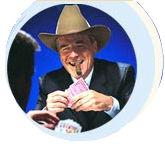So says Tom Blair, former mayor of Deadwood and one of the driving forces
behind the legalization of gambling in the small town of 1,800 people. It's
been 20 years since the legislature nixed plans to bring legalized gambling
to Deadwood, in an effort to turn back the slow demise of the Wild West
town. That effort began back in the summer of 1986, when Blair and his wife
Linda, Bill Walsh, Melody Nelson, Mike Trucano, Mary Dunn and David Larson
got together and began brainstorming ways to revitalize the downtown. They
looked to the past and realized reviving gambling in Deadwood was just the
ticket. Together the group formed the Deadwood You Bet Committee in November
of that year and began the task of convincing South Dakota legislators the
state needed legalized gambling. They went to the legislature in 1987, but
they got nowhere with the body. "There were 100 different issues from 100
different people during this campaign, and the legislators weren't sure what
this was about, so they voted no," said Blair. Another thing learned from
the defeat was that people wanted to know what money being raised by
gambling would be used for. "You have to title the money, and we were able
to do that, with events like the Syndicate fire, and then the county's
attempt to tear down the historic courthouse. We told the people of the
state that gambling would help save Deadwood, otherwise it could end up
being lost," Blair said.Even with a defeat under their belts, the Deadwood
You Bet Committee was ready to pick up the fight again. "We were eternal
optimists. Here we were in a conservative state, trying to convince the
people of South Dakota to do this. Fortunately, we had people who really
believed this was the way to 0go," said Blair. The group gathered
signatures, and filed a petition for the election of 1988 in late 1987. They
then spent all of 1988 campaigning for the issue. And it wasn't just this
gang of seven that worked on the project. "We had hundreds of people from
all over the Lead-Deadwood area coming in, and we had a huge office where
Hickok's is now, and they would come in and answer phones and perform other
duties," he said. The seven members of the committee took turns speaking
wherever they could, from small meetings to large events. They even procured
a wagon and rode in parades. Blair said the committee begged borrowed or
stole whatever and whenever they could. In three years, the members spent
about $120,000 on the campaign, some of it out of their own pockets.
Finally, in November 1988, voters approved the measure.
"We were lucky to start on November 1 when we did. The last days of October
were crazy. There were only two or three casinos in Deadwood that day, and
they were scrambling to get their people in place by the First," he said.
A downside to gambling in the eyes of many was the demise of retail stores
on Deadwood's main street that were replaced by casinos. But Blair
acknowledges this by saying while gambling is the focus of Main Street now,
that does not mean normal retail businesses can't resume business on the
outskirts of town.
"The city of Deadwood worked with Lead to help attract retail businesses,
and they were able to get a commitment from a developer and the result was
the Twin City Mall, which still operates and houses a grocery store and
bowling alley and department store.
In the meantime, it was thought if wages could rise above the $5 limit, both
Deadwood and the entire state would benefit. Deadwood certainly would
attract high rollers, or at least those who could afford to place a higher
bet.
Actor Kevin Costner said he needed the higher limits to support his planned
Dunbar resort on Deadwood Hill just north of town. But voters were not
convinced and the measure failed. One more attempt failed as well, but in
November 2000, the increase was approved.
Since the inception of gambling in 1989, over $10 billion has been wagered
in Deadwood, and $71 million has been collected as taxes. That money is
earmarked for tourism promotion, Lawrence County and historic preservation.
Deadwood Historic Preservation funds have been used for a wide variety of
projects all over the state, as well as the city itself.
Tom Blair is proud of what he and his colleagues accomplished. "We took an
idea, and we presented it to the people of South Dakota. The result is we've
been able to revitalize a town that was slowly dying, and make it a
destination for millions of visitors. And we've also had a hand in
preserving the history of the area and the whole state. That's what I want
to be remembered for."
